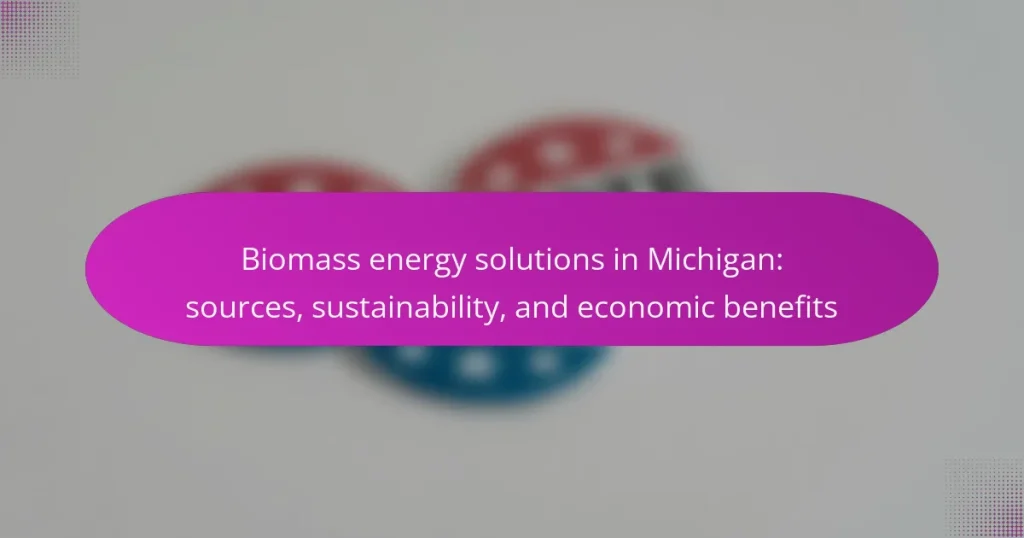
What are biomass energy solutions in Michigan?
Biomass energy solutions in Michigan include the use of organic materials to generate energy. These solutions utilize agricultural residues, wood waste, and dedicated energy crops. Biomass can be converted into electricity, heat, or biofuels. Michigan has several biomass facilities that produce renewable energy. For instance, the Consumers Energy biomass plant in Grayling generates power from wood waste. This approach reduces greenhouse gas emissions compared to fossil fuels. Additionally, biomass energy supports local economies by creating jobs in the renewable energy sector. According to the Michigan Biomass Energy Program, biomass contributes significantly to the state’s renewable energy goals.
How do biomass energy solutions contribute to energy production?
Biomass energy solutions contribute to energy production by converting organic materials into usable energy. This process involves the combustion, fermentation, or anaerobic digestion of biomass such as wood, agricultural residues, and waste. In Michigan, biomass energy accounts for a significant portion of renewable energy sources. According to the U.S. Energy Information Administration, biomass provided about 1.5% of Michigan’s total electricity generation in 2020. Biomass energy is considered carbon-neutral since the carbon dioxide released during energy production is offset by the carbon dioxide absorbed by the plants during their growth. Additionally, biomass can help reduce reliance on fossil fuels, promoting energy sustainability. The utilization of local biomass resources also supports the state’s economy by creating jobs in agriculture and energy sectors.
What types of biomass materials are commonly used in Michigan?
Common biomass materials used in Michigan include wood residues, agricultural residues, and energy crops. Wood residues consist of sawdust, wood chips, and bark from the forestry and lumber industries. Agricultural residues include corn stalks, wheat straw, and other plant materials left after harvest. Energy crops, such as switchgrass and miscanthus, are specifically grown for biomass production. These materials are utilized for bioenergy production, contributing to renewable energy sources in the state. The Michigan Biomass Energy Program supports the use of these materials to promote sustainability and economic growth.
How is biomass converted into usable energy?
Biomass is converted into usable energy through processes like combustion, gasification, and anaerobic digestion. Combustion involves burning biomass to produce heat, which generates steam to drive turbines for electricity. Gasification transforms biomass into a gas called syngas, which can be used for power generation or as a chemical feedstock. Anaerobic digestion breaks down organic matter in the absence of oxygen, producing biogas that can be used for heating or electricity. These methods utilize various types of biomass, including agricultural residues, wood chips, and organic waste. According to the U.S. Energy Information Administration, biomass accounted for about 5% of total U.S. energy consumption in 2021, demonstrating its role as a renewable energy source.
Why is biomass energy considered sustainable?
Biomass energy is considered sustainable because it utilizes organic materials that can be replenished. These materials include agricultural residues, wood, and waste. Biomass can be sourced from local environments, reducing transportation emissions. When managed responsibly, biomass production does not deplete natural resources. It can also help in carbon sequestration by maintaining forest health. According to the U.S. Department of Energy, biomass energy can reduce greenhouse gas emissions by 80% compared to fossil fuels. This makes it a viable alternative in the transition to a low-carbon economy.
What are the environmental impacts of biomass energy production?
Biomass energy production has several environmental impacts. It can lead to deforestation and habitat loss when trees are harvested unsustainably. This practice reduces biodiversity and disrupts ecosystems. Additionally, burning biomass releases carbon dioxide and other pollutants into the atmosphere. According to the U.S. Environmental Protection Agency, biomass combustion can emit particulate matter, which affects air quality. Water usage is another concern, as biomass production may require significant water resources for processing. Furthermore, improper management of biomass waste can lead to soil and water contamination. Therefore, while biomass energy can be renewable, its production must be managed carefully to mitigate these environmental impacts.
How does biomass energy compare to fossil fuels in terms of sustainability?
Biomass energy is generally considered more sustainable than fossil fuels. Biomass is derived from organic materials, which can be replenished over time. In contrast, fossil fuels are finite resources formed over millions of years. The carbon cycle associated with biomass allows for carbon neutrality when managed properly. This means that the carbon dioxide released during biomass combustion can be offset by the carbon absorbed during the growth of new biomass. According to the U.S. Department of Energy, biomass energy can reduce greenhouse gas emissions by 80% compared to fossil fuels. Additionally, biomass can support local economies by utilizing waste materials, whereas fossil fuel extraction often leads to environmental degradation.
What economic benefits do biomass energy solutions provide in Michigan?
Biomass energy solutions provide significant economic benefits in Michigan. They create jobs in both the biomass production and processing sectors. According to a 2020 report by the Michigan Biomass Energy Coalition, biomass energy supports approximately 6,000 jobs statewide. Biomass energy also contributes to local economies by utilizing regional agricultural residues and forestry byproducts. This reduces waste and generates additional income for farmers and landowners. Furthermore, biomass energy can help stabilize energy prices by providing a local, renewable energy source. The Michigan Department of Agriculture and Rural Development states that biomass can enhance rural economic development. Overall, biomass energy solutions promote sustainability while boosting Michigan’s economy.
How does biomass energy create jobs in local communities?
Biomass energy creates jobs in local communities through various processes. First, it requires local workforce involvement in harvesting biomass materials. This includes agricultural residues, wood waste, and energy crops. Second, biomass energy facilities need skilled labor for operation and maintenance. This creates positions in engineering, management, and technical support.
Third, the development of biomass energy projects stimulates local economies. It leads to increased demand for goods and services, benefiting local suppliers. According to the U.S. Department of Energy, biomass energy can generate thousands of jobs in rural areas. For instance, a study by the Biomass Power Association indicated that biomass facilities can create approximately 1.5 jobs for every megawatt of energy produced.
Additionally, biomass energy contributes to job creation in transportation and logistics. This involves moving biomass materials to energy plants. Overall, biomass energy initiatives provide sustainable employment opportunities while supporting local economies.
What is the potential for biomass energy to reduce energy costs?
Biomass energy has significant potential to reduce energy costs. It can provide a locally sourced alternative to fossil fuels. This reduces transportation costs and price volatility associated with imported energy. According to the U.S. Department of Energy, biomass can lower energy bills by utilizing waste materials. In Michigan, biomass energy can leverage agricultural and forestry residues. This local utilization can lead to job creation and economic growth. A study by the Michigan Biomass Energy Program found that biomass can offer stable pricing compared to traditional energy sources. Therefore, biomass energy contributes to long-term energy cost savings.
How do biomass energy solutions impact local ecosystems?
Biomass energy solutions can significantly impact local ecosystems. These solutions often involve the conversion of organic materials into energy, which can alter land use patterns. The removal of biomass for energy production may lead to habitat loss for various species. Additionally, intensive biomass harvesting can reduce soil quality and disrupt local water cycles.
Research indicates that sustainable biomass practices can mitigate some negative effects. For example, maintaining biodiversity through careful selection of biomass sources can help preserve ecosystem balance. Studies show that when managed responsibly, biomass energy can coexist with local flora and fauna. This balance is crucial for maintaining ecological integrity.
What measures are taken to ensure responsible sourcing of biomass?
Measures to ensure responsible sourcing of biomass include adherence to sustainability certifications. Organizations often follow guidelines set by the Sustainable Forestry Initiative (SFI) or the Forest Stewardship Council (FSC). These certifications verify that biomass is sourced from sustainably managed forests. Additionally, companies may conduct life cycle assessments to evaluate environmental impacts. They also engage in stakeholder consultations to address community concerns. Regular audits are performed to ensure compliance with sourcing standards. Transparency in supply chains is maintained to track biomass origins. These practices collectively promote responsible biomass sourcing.
How does biomass energy production affect biodiversity in Michigan?
Biomass energy production can negatively affect biodiversity in Michigan. The process often involves land conversion for biomass crop cultivation. This can lead to habitat loss for native species. Additionally, the use of forest resources for biomass can disrupt local ecosystems. Studies show that intensive biomass harvesting can reduce species richness. The Michigan Department of Natural Resources highlights the importance of maintaining biodiversity. Sustainable practices are essential to mitigate these impacts. Without careful management, biomass energy production may threaten wildlife and plant diversity in the state.
What challenges are associated with biomass energy solutions?
Biomass energy solutions face several challenges. One significant challenge is the availability of sustainable feedstock. Ensuring a consistent supply of biomass materials can be difficult. Competition for agricultural land can limit biomass production. Another challenge is the emissions associated with biomass combustion. While biomass is renewable, it can still release greenhouse gases. Additionally, the technology for converting biomass to energy can be costly. High capital investment may deter potential investors. Lastly, public perception can hinder biomass projects. Concerns about land use and environmental impacts can lead to opposition. These challenges complicate the implementation of biomass energy solutions in Michigan.
What are the common misconceptions about biomass energy?
Common misconceptions about biomass energy include the belief that it is entirely carbon-neutral. While biomass does release carbon dioxide, it can offset this by sequestering carbon during growth. Another misconception is that biomass energy is derived solely from waste. In reality, it also comes from dedicated energy crops. Some people think biomass energy is inefficient compared to fossil fuels. However, modern biomass technologies can be highly efficient, with conversion efficiencies exceeding 80%. Additionally, there is a belief that biomass energy contributes significantly to deforestation. Sustainable practices can mitigate this risk, ensuring responsible sourcing. Lastly, many assume that biomass energy does not contribute to energy security. In fact, utilizing local biomass resources can enhance energy independence.
How can these challenges be addressed effectively?
Addressing challenges in biomass energy solutions in Michigan requires strategic planning and collaboration. First, improving technology for biomass conversion can enhance efficiency. Advanced methods, such as gasification and anaerobic digestion, can increase energy yield. Second, securing consistent feedstock supply is crucial. Establishing partnerships with local agricultural and forestry sectors can ensure a reliable biomass source. Third, regulatory frameworks must support biomass development. Streamlining permits and incentives can encourage investment in biomass projects. Additionally, public awareness campaigns can educate communities on biomass benefits. Research shows that states with strong biomass policies see increased economic growth. For example, Minnesota’s biomass initiatives led to job creation and energy diversification. Implementing these strategies can effectively address challenges in Michigan’s biomass energy sector.
What are best practices for implementing biomass energy solutions in Michigan?
Best practices for implementing biomass energy solutions in Michigan include conducting thorough resource assessments, ensuring sustainable sourcing of biomass, and engaging local stakeholders. Resource assessments identify available biomass feedstocks, such as agricultural residues and wood waste. Sustainable sourcing practices minimize environmental impacts and support local economies. Engaging stakeholders, including community members and businesses, fosters support and collaboration. Additionally, developing partnerships with research institutions enhances innovation and access to best practices. Implementing efficient conversion technologies maximizes energy output from biomass. Regular monitoring and evaluation of projects ensure they meet environmental and economic goals.
How can businesses integrate biomass energy into their operations?
Businesses can integrate biomass energy into their operations by utilizing biomass as a renewable energy source. They can install biomass boilers to convert organic materials into heat. This process can reduce fossil fuel dependency and lower energy costs. Companies can also partner with local biomass suppliers for consistent fuel sources. Implementing energy-efficient technologies alongside biomass systems enhances overall efficiency. Additionally, businesses can participate in government programs that support biomass energy adoption. These initiatives often provide financial incentives and technical assistance. According to the U.S. Department of Energy, biomass energy can significantly contribute to reducing greenhouse gas emissions.
What resources are available for communities interested in biomass energy?
Communities interested in biomass energy can access various resources. The U.S. Department of Energy provides information on biomass technologies and funding opportunities. The Biomass Research and Development Initiative offers grants for biomass projects. Local universities often conduct research and provide expertise in biomass energy. Nonprofit organizations also offer educational materials and support for community initiatives. Additionally, state agencies may have programs to promote biomass energy development. These resources help communities understand and implement biomass energy solutions effectively.
Biomass energy solutions in Michigan leverage organic materials such as agricultural and wood residues to generate renewable energy, including electricity, heat, and biofuels. This article examines the types of biomass materials used, the conversion processes involved, and the sustainability of biomass energy compared to fossil fuels. It also highlights the economic benefits, including job creation and local economic support, as well as the environmental impacts and challenges associated with biomass energy production. Furthermore, it discusses best practices for implementing biomass energy solutions and resources available for communities interested in adopting these technologies.


